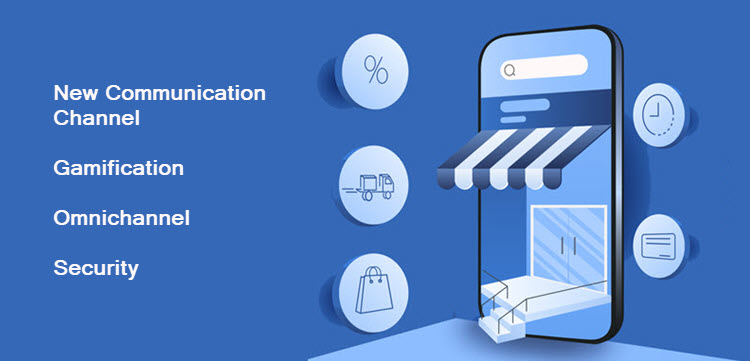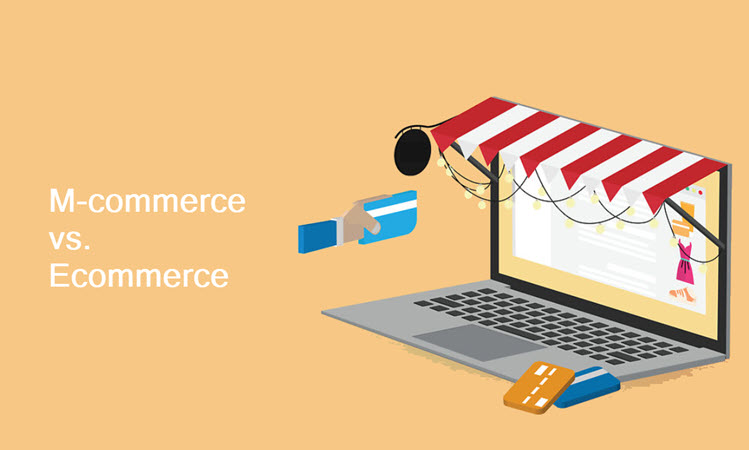Buying and selling goods and services online has become the new norm since the beginning of the pandemic. Traditional brick-and-mortar stores rushed to open ecommerce shops, while others went one step ahead and developed a mobile commerce (m-commerce) strategy. With $431 billion in retail sales in the US alone, m-commerce proves to be a lucrative subcategory of ecommerce.
In this article, learn about the key differences between m-commerce and ecommerce and why online retailers should consider using m-commerce to their advantage.
M-commerce vs. Ecommerce: Key Differences

Both m-commerce and ecommerce have the goal of selling products and services online. Still, there are several distinctive differences between m-commerce and ecommerce:
Portability
While ecommerce and m-commerce both require the use of internet, they are optimized for different devices. Ecommerce purchases are conducted through websites consumers access via desktop and laptop devices. The fact is that a lot of online shops/websites provide poor mobile UX. This is where m-commerce comes in.
By creating smartphone applications, stores and companies allow users to seamlessly browse through products and make purchases. The biggest names in the ecommerce industry such as Amazon and eBay already know that ecommerce and m-commerce complement each other. That is why their online stores are available on both desktop and laptop devices through highly responsive websites and on mobile devices through easy-to-use mobile apps.
Costs
M-commerce relies on the use of mobile apps, which are more expensive to make in comparison to most ecommerce websites. Making a smartphone app requires hiring a developer and picking a platform (IOS, Android or both).
In ecommerce, however, making an online store is a lot easier and cheaper. Today’s website builders do not require prior knowledge of website development or design. This means that anyone can start an online shop and design a website in a few simple steps. Also, builders and ecommerce platforms offer other services such as website hosting and maintenance, which take the pressure off merchants.
Versatility
While ecommerce is almost exclusively used in online retail, m-commerce finds its role in multiple industries. Besides online retail, m-commerce apps are used in online banking, virtual marketplaces and as mobile wallets.
Customer Insights
Thanks to the portability of mobile devices, online shops get insights into their customers’ location through Wi-Fi and GPS. This way, they create location-specific recommendations for shopping, as well as personalized and limited offers.
Ecommerce used to lack this advantage since desktop devices are tied to a specific location. However, via multi-device accounts (e.g., Google accounts), customers are now connecting their devices and receiving the same insights about their favorite online (and physical) stores. This provides an equally enjoyable shopping experience on all devices.
What Is Ecommerce?
Ecommerce is the process of buying and selling goods and services online. This includes not only physical products but also digital assets such as memberships, subscriptions and other online services.
Ecommerce business transactions include B2B, B2C, C2C and even C2B sales with all purchases being completed over the internet.
What Is M-commerce?

M-commerce refers to ecommerce purchases made via mobile devices. Mobile commerce or m-commerce is a subset of ecommerce. M-commerce requires the use of mobile devices such as smartphones and tablets to provide an online shopping experience through smartphone apps.
However, m-commerce is not tied to online purchases only. There are three types of m-commerce:
- Mobile shopping. Mobile shopping is the act of buying and selling products and services via mobile devices. According to a survey conducted in 2021, 6 out of 10 shoppers in the US plan to increase their in-app purchases in the next 5 years.
- Mobile banking. M-commerce allows you to make online financial transactions. This includes paying your bills and making other personal transactions, as well as international transfers.
- Mobile Payments. Smartphones enable individuals to make payments to other people, not only to companies and banks. In just a few clicks, you can safely transfer funds from your bank account to an account of your choosing.
M-commerce Advantages
M-commerce is an evolution of ecommerce that adopts existing ecommerce advantages and further optimizes them. It also introduces a new communication channel that is an integral part of any well-designed omnichannel customer experience.

Below is a list of the most prominent m-commerce advantages:
New Communication Channel
M-commerce businesses reach customers directly through push notifications. Before the widespread of m-commerce, online stores were sending newsletters and email promotions to their customers. However, they often ended up in spam folders without ever being seen by the receiver. Users are more likely to respond to a notification they receive on their mobile phone than to a newsletter.
M-commerce stores and companies set up push notifications to promote special offers, maintain communication with customers, and get their messaging right in front of their target audience. With the use of push notifications, customers also receive updates about their favorite products being on sale or back in stock.
Tip: Push notifications are an excellent tool for upselling and cross-selling. Learn how they work and about best practices in our post How to Use Web Push Notifications for Ecommerce.
Gamification
Gamification creates interest in customers through rewards and achievements. Online stores provide discounts and special offers if you win a quick and easy game or a quiz in their mobile app. Gamification encourages customers to keep playing and shopping. This is an especially useful method of retaining customers who have abandoned their carts.
Gamification also uses referral and loyalty programs to reward the customers while acquiring new ones. For example, every referral is rewarded with a special discount code. On the other hand, loyalty programs encourage customers to repeat purchases and redeem physical or virtual rewards.
Omnichannel
M-commerce is so lucrative that it would be unwise not to include it in an omnichannel strategy. Omnichannel is a sales and marketing approach in which an organization uses multiple, mutually interconnected sales and communication channels. It may include m-commerce, ecommerce, physical and social media stores.
Smartphones are so popular and omnipresent that you cannot neglect this communication channel if you are building a holistic sales and marketing strategy. It presents the perfect opportunity to interconnect multiple sales channels that may all be optimized for mobile devices.
For example, merchants use the customer preference data collected via mobile devices to provide a better brick-and-mortar customer experience. Similarly, showrooming a product in a brick-and-mortar store should include a special online promo to hook the buyer.
Note: Learn more about current omnichannel retail trends and how m-commerce is used in combination with other sales channels.
Security
The safety of data and money in online transactions is an important issue in ecommerce and m-commerce. Credit cards are the preferred payment method in ecommerce, while multi-factor authentication is the mechanism that ensures the safety of online payments.
M-commerce goes even further in providing extra security by using mobile wallets such as Google Pay and Apple Pay. Mobile wallets support the smartphone’s native hardware capabilities and make use of biometric authentication, thus adding one more layer of security. This additional authentication method enhances the overall security of mobile payments through facial recognition, retina scans or fingerprint ID in digital wallets.
Conclusion
In recent years, ecommerce and m-commerce have become an essential part of online shopping and banking across the globe. Especially since the pandemic outbreak, shoppers are turning to online shops to buy goods and services.
Retailers should adjust to customer demands to provide a unified sales and marketing experience via any device. This would allow merchants to personalize each customer interaction and build a recurring customer base.
